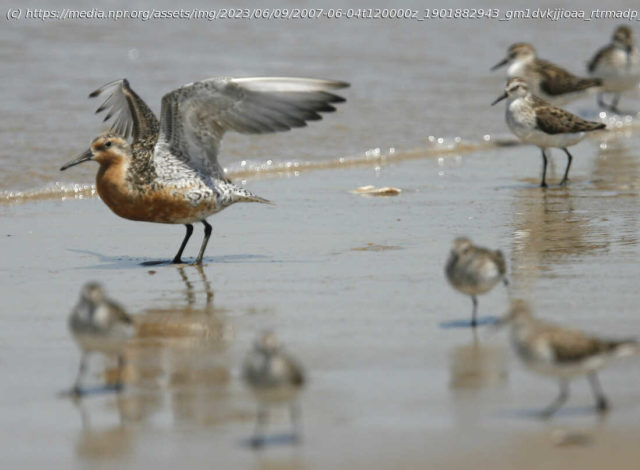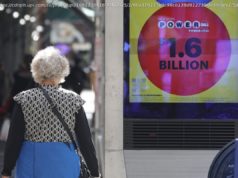Array
Horseshoe crabs used to be everywhere. Millions of years before dinosaurs roamed the planet, each spring, the hard-shelled creatures gathered to mate in massive mounds along the beaches of the Atlantic coast. Later, migratory shorebirds like the robin-sized red knot learned to fly up from South America to join them for a feast. The crabs’ eggs gave the birds the energy they needed to keep flying north to breed in the Arctic.
But humans began to want something from the crabs, too – their blood. In the 1960s, scientists discovered that the sky blue blood inside horseshoe crabs would clot when it detected bacterial toxins. Vaccines, drugs and medical devices have to be sterile before they’re put inside people. A better toxin detection system meant less contamination risk for patients, so fishermen soon started collecting and selling the prehistoric animals to be bled.
A synthetic alternative was later invented and has since been approved in Europe as an equivalent to the ingredient that requires horseshoe crabs. But in the U.S., the blood harvest isn’t shrinking. It’s growing. Five companies along the East Coast, with operations in South Carolina, New Jersey, Massachusetts, Virginia, and Maryland, drained over 700,000 crabs in 2021. That’s more than any year since officials started keeping track in 2004. Since then, the number of crabs bled by the industry has more than doubled. At least 80 million tests are performed each year around the world using the blood-derived ingredient.
As the industry has expanded, coast-wide regulation has been limited and the companies have become increasingly secretive. Records obtained by NPR indicate that in some states, fishermen paid by the bleeding companies have handled crabs in ways that research has shown to cause harm or have violated harvest laws without punishment. Meanwhile, the process of approving the alternative in the U.S. has stalled even as the number of birds in the sky has plummeted.
The federal government designated one of the migratory shorebird species that depends on horseshoe crab eggs, the red knot, as threatened. About 94% of red knots have disappeared over the past 40 years. Horseshoe crabs have become moderately depleted along the Atlantic coast, the International Union for Conservation of Nature determined. The ones around New England are noted as particularly vulnerable to extinction.
« We’re up against this system that really prioritizes money over the health of the stock, » said Larry Niles, a wildlife biologist and leader of the nonprofit Horseshoe Crab Recovery Coalition. « And the consequences show it. »A profitable gray area
Depending on which state they’re harvested in, the crabs are either taken by hand from the beaches or pulled up from the bottom of the ocean with nets. Hundreds are piled on top of each other in boats, loaded into trucks and delivered to bleeding facilities. There, lab technicians pierce the crabs through their hearts and drain them alive, sometimes for eight minutes, which can deplete them of more than half their volume of blue blood. In Massachusetts, some of the bled crabs are then sold to be killed and used as bait. In states like South Carolina and New Jersey, the animals are delivered back to the fishermen, who return them to the ocean.
That makes the bleeding business unique among the industries it straddles. It’s an unusual fishery, because the animals are not sold to be eaten. It’s an atypical utilization of animals in medicine, since the crabs are not bled in the research stage, and they’re not warm-blooded. They’re not even crustaceans – horseshoe crabs are more closely related to scorpions than they are to snow crabs.
The business is also different from extractive industries like mining and logging, because the harvested natural resource is supposed to be returned to the environment alive.
« They sort of fall through the cracks a little bit in terms of what you could call the regulatory imagination, » said Rich Gorman, a research fellow at Brighton and Sussex Medical School in England. « Everyone assumes that everyone else is regulating it. »
Family businesses used to own many of the smaller facilities in the earlier days of bleeding. Now, the industry is dominated by giant multinational firms, like a facility in Virginia owned by the Japanese conglomerate Fujifilm, and Charles River Laboratories, a publicly traded company based in Massachusetts that took over a local operation in South Carolina.
Federal laws require some animals used by biomedical industries to be treated humanely. The Animal Welfare Act protects some warm-blooded animals, like monkeys, that are used in scientific research. The Health Research Extension Act covers other vertebrates, like mice, that aren’t included in the Welfare Act.
But coast-wide regulations regarding humane treatment of the crabs are virtually nonexistent or unenforced. The Atlantic States Marine Fisheries Commission manages stocks of fish meant to be quickly killed, like sea bass and flounder. It also manages horseshoe crabs, though the animals can spend dozens of hours alive above water during the harvest and bleeding process.
« Thinking of horseshoe crabs as a fishery, it really complicates and muddies the debate, » said Gorman. « The aftercare that’s involved in any scientific procedure that’s carried out on an animal is really important. »
The fisheries commission does publish a description of « Best Management Practices » for the industry, but those are guidelines, not laws. And they’re often disregarded.
NPR obtained audio recorded during a meeting in January when those best practices were being discussed. Participants on the call can be heard mentioning that research shows picking crabs up by their tails harms the animals.
Home
United States
USA — Art Coastal biomedical labs are bleeding more horseshoe crabs with little accountability






